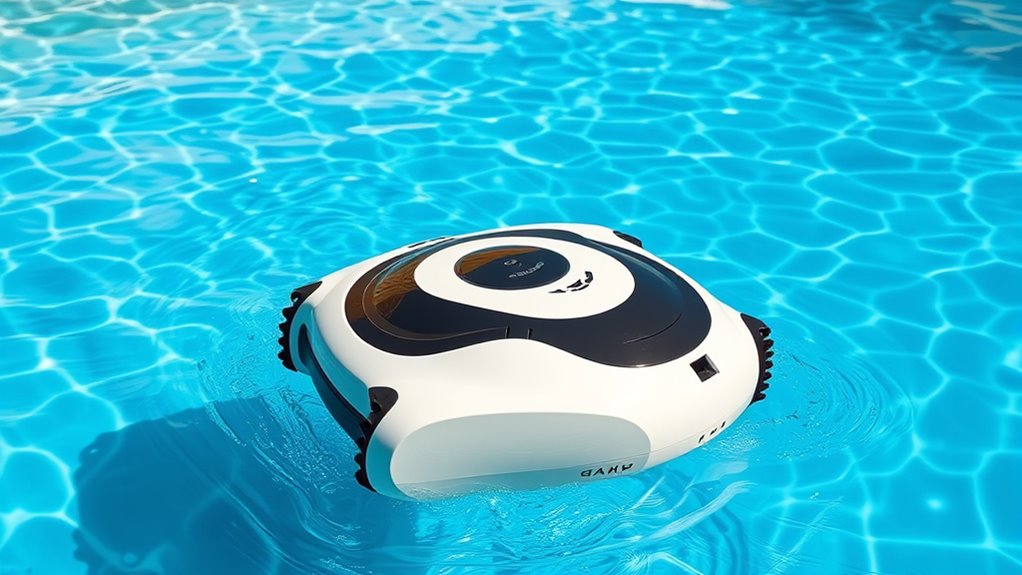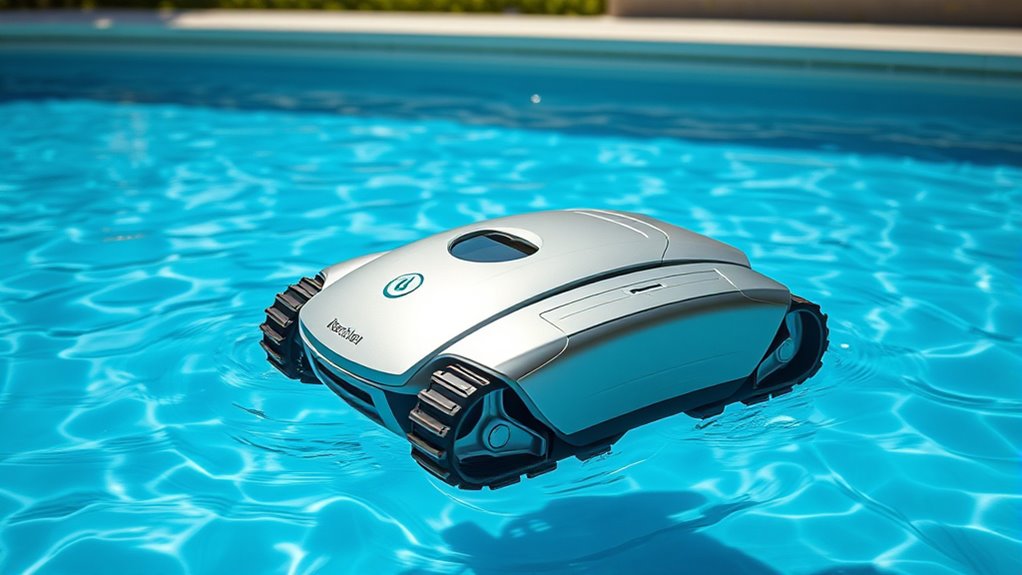Robotic pool cleaners are transforming pool maintenance by offering smart, autonomous solutions that make cleaning effortless. They map your pool layout, plan efficient routes, and adapt to obstacles, ensuring every inch gets cleaned—bottom, sides, and waterline. With real-time monitoring, programmable schedules, and energy-efficient operation, you’ll enjoy a sparkling pool with minimal effort. If you want to discover how these innovative devices are shaping hassle-free pool care, there’s more to explore ahead.
Key Takeaways
- Advanced navigation systems enable robotic cleaners to map and adapt to various pool shapes for comprehensive coverage.
- Real-time monitoring and programmable schedules automate cleaning, reducing manual oversight and maintaining consistent pool hygiene.
- Energy-efficient motors and smart programming optimize power use, lowering costs and extending device lifespan.
- User-friendly design allows quick deployment, automatic adaptation to obstacles, and minimal manual effort.
- Continuous technological advancements promise more precise, reliable, and eco-friendly pool maintenance solutions.

Robotic pool cleaners have revolutionized how homeowners maintain their pools by offering an efficient, hands-free solution to cleaning. These devices do more than just scrub the bottom; they come equipped with smart navigation systems that map out your pool’s layout, ensuring thorough coverage without missing spots. With smart navigation, you don’t have to worry about manually steering the cleaner or missing hard-to-reach areas. Instead, the robot intelligently plans its route, adjusting as needed to clean every inch of your pool efficiently. This advanced feature not only saves you time but also guarantees a more all-encompassing clean compared to traditional cleaners or manual scrubbing. Additionally, many models feature real-time monitoring, allowing you to track the cleaning progress remotely and ensure optimal performance. Energy efficiency is another major advantage of modern robotic pool cleaners. Unlike older models that may run continuously or waste power on unnecessary movements, newer devices optimize their energy use through smart programming. They analyze the pool’s size, shape, and debris levels to determine the most effective cleaning pattern, which minimizes power consumption. This means you spend less on electricity while still enjoying a pristine pool. Additionally, many models have energy-efficient motors designed to operate quietly and with minimal power draw, making them environmentally friendly and cost-effective in the long run. Your convenience is at the forefront of robotic cleaner design. You simply need to place the robot in the water, press a button, and let it do its job. Because of their smart navigation, these cleaners adapt to different pool shapes and obstacles, avoiding getting stuck or wasting energy on unnecessary routes. They can clean the bottom, sides, and waterline with minimal intervention. Some models even feature programmable schedules, so your pool gets cleaned regularly without you lifting a finger. This automation not only keeps your pool consistently clean but also reduces the physical effort involved in manual cleaning or supervising traditional robotic cleaners. Furthermore, the combination of smart navigation and energy efficiency means these cleaners are reliable and economical. They tend to last longer because they operate more efficiently and aren’t overexerting their motors. You’ll appreciate how quickly they return to their docking station after finishing, ready to be used again when needed. As technology advances, expect even smarter navigation systems that learn your pool’s unique layout over time, making cleaning even more precise and energy-conscious. With a robotic pool cleaner, you’re investing in a future where maintaining your pool becomes simpler, more effective, and environmentally friendly, freeing up your time and energy for enjoying your pool instead of cleaning it.
Frequently Asked Questions
How Long Do Robotic Pool Cleaners Typically Last?
You can expect your robotic pool cleaner to last around 3 to 8 years, depending on usage and maintenance. Battery life typically diminishes over time, so regularly charging and avoiding deep discharges helps prolong its lifespan. Follow maintenance tips like cleaning filters and checking brushes to keep it running smoothly. Proper care guarantees your robot stays efficient longer, saving you money and hassle in the long run.
Are Robotic Pool Cleaners Suitable for All Pool Types?
Think of your pool as a garden needing the right tools; robotic pool cleaners are versatile and suitable for many pool types, from inground to above-ground. They help guarantee pool safety by maintaining cleanliness, reducing hazards. To keep your cleaner performing well, follow maintenance tips like regular filter checks and debris removal. If you choose the right model, it’ll seamlessly adapt to your pool’s shape and surface, making upkeep effortless.
What Is the Average Energy Consumption of These Devices?
You’ll find that robotic pool cleaners are quite energy-efficient, with an average power consumption of around 50 to 200 watts per hour. Their energy efficiency means you save on electricity bills compared to traditional cleaning methods. Most models are designed to optimize power consumption, so you get thorough cleaning without wasting energy. Keep in mind, higher-end models may use slightly more power but offer advanced features, balancing performance and energy efficiency effectively.
Can Robotic Pool Cleaners Be Used in Saltwater Pools?
Yes, you can definitely use robotic pool cleaners in saltwater pools. Think of them as sailors steering a salty sea—they’re designed with saltwater compatibility in mind. These devices typically feature corrosion resistance, guaranteeing they withstand the harsh, salty environment without damage. Just make sure to check the manufacturer’s specifications for saltwater compatibility to verify your robotic cleaner will perform at its best and last longer in your saltwater pool.
How Often Should Filters Be Replaced or Cleaned?
You should clean your robotic pool filter regularly, ideally once a week during peak usage, to guarantee ideal filter maintenance. Replace the filter every six months or when you notice a significant decrease in cleaning performance. Proper filter maintenance and timely replacement of filters help keep your pool clean and extend the life of your robotic cleaner. Staying on top of this schedule prevents clogging and maintains efficient operation.
Conclusion
With a robotic pool cleaner, you’ll never have to lift a finger to keep your pool pristine. Imagine a device so efficient, it works tirelessly like a fleet of tiny underwater robots, leaving your pool spotless without any hassle. Say goodbye to scrubbing and vacuuming — these cleaners are truly the superheroes of pool maintenance. Embrace the future today and enjoy crystal-clear water whenever you want, making your backyard the envy of the neighborhood.









